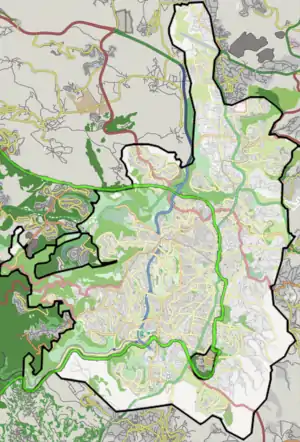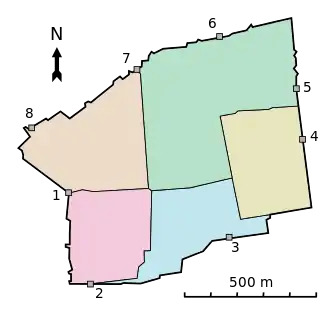| Sidna Omar Mosque | |
|---|---|
مسجد سيدنا عمر | |
 | |
| Religion | |
| Affiliation | Islam |
| Rite | Sunni |
| Governing body | Jerusalem Waqf[1] |
| Location | |
| Location | Old City of Jerusalem |
 Shown within Jerusalem | |
| Geographic coordinates | 31°46′30″N 35°13′52″E / 31.77500°N 35.23111°E |
| Architecture | |
| Type | mosque |
| Style | Mamluk |
| Date established | Before[2] or after 1400,[3] Mamluk period |
| Minaret(s) | 1 |
The Sidna Omar Mosque (Arabic: مسجد سيدنا عمر, lit. 'Lord Omar mosque') is a Mamluk-era mosque in the Jewish Quarter of the Old City of Jerusalem. It stands adjacent to the Hurva and Ramban Synagogues.[1]
After Israel captured East Jerusalem, including the Old City of Jerusalem, in the Six-Day War, the mosque was closed, and has been closed ever since.
History
.jpg.webp)
.jpg.webp)
The earliest reference know to the mosque was made by historian Mujir al-Din (born in 1496), who mentions the mosque was renovated in 1397, with funds collected and land donated to maintain it.[2] Obadiah Bartenura wrote that the mosque was built by a Jew who had converted to Islam.[4]
In the Six-Day War, the minaret was hit by snipers and was renovated in 1974.[2]
Further renovations to the building were done in 2019, paid for by the government of Jordan.[1]
Description
The minaret is typical of the Mamluk period. It rises two stories high and is topped by a balcony for the muezzin. The upper part of the minaret is narrower than its base in order to stabilize the structure.[2]
Archaeology
Some columns found inside the mosque have led to it being associated with the Crusader Church of St Martin in the late nineteenth century;[5] according to Burgoyne since the columns are in their secondary use "this tenuous link between the mosque and the church cannot be maintained."[2]
References
- 1 2 3 Yedid, Baruch (19 November 2019). "Jordan Reopening Mosque Adjacent to Hurva Synagogue in Heart of Jerusalem's Jewish Quarter". Jewish Press. Retrieved 2022-06-22.
- 1 2 3 4 5 Burgoyne (1984). Mamluk Jerusalem: An Architectural Study, p. 513.
- ↑ Wager, Eliyahu (1988). Ramban Synagogue. Jerusalem: The Jerusalem Publishing House. p. 60.
{{cite book}}:|work=ignored (help) - ↑ Friedson, Yael (21 November 2011). ""עוד יהיה כאן פיצוץ": בקרוב מסגד בלב הרובע היהודי ("There will be another explosion here": Soon a mosque in the heart of the Jewish Quarter)". Ynet (in Hebrew).
A year ago, the King of Morocco renovated the Disi Mosque (the second of the two mosques in the Jewish Quarter), but the residents and the community manager reached quiet agreements with moderate representatives of the Waqf, according to which prayers will be held there - without muezzin calls.
- ↑ Hanauer, J. E., The Churches of St. Martin and St. John the Evangelist and subsequent letters, Palestine Exploration Quarterly, 1893, pages 301 onwards.



.jpg.webp)